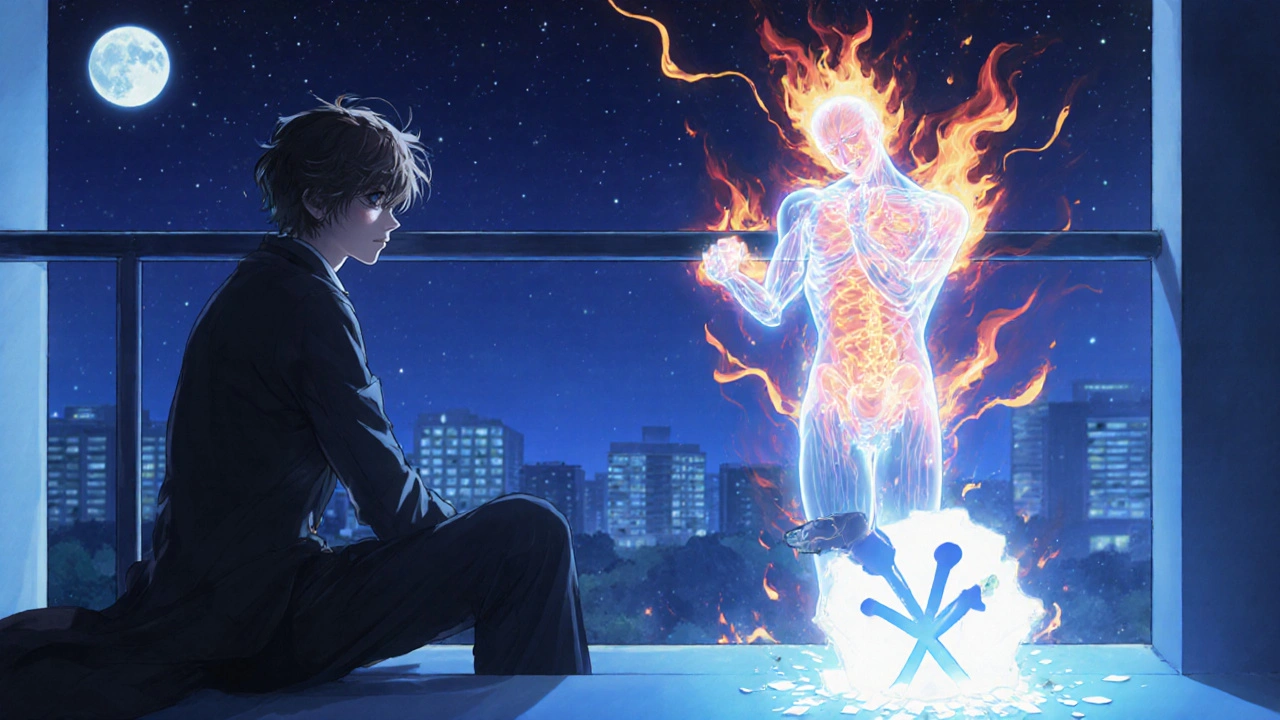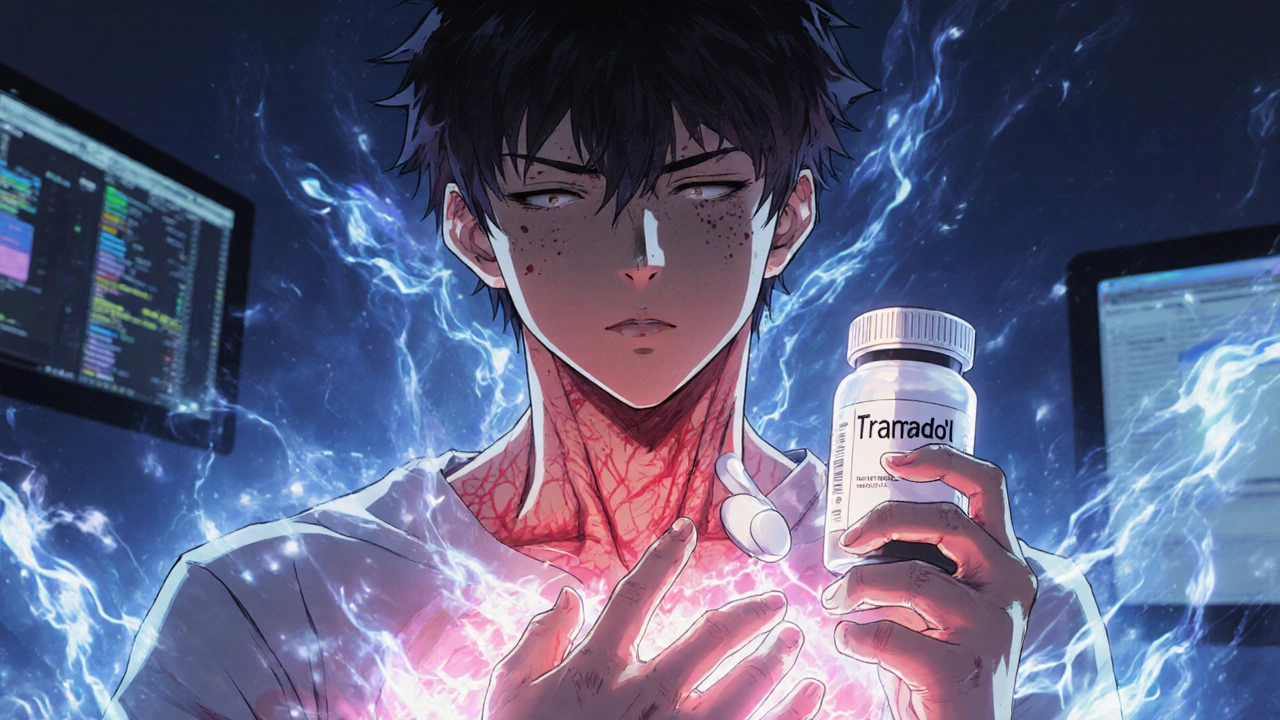Tramadol Interaction Risk Checker
This tool checks if your current medications increase your risk of serotonin syndrome when taking tramadol. Serotonin syndrome is a life-threatening condition that can occur when tramadol is combined with certain medications, including antidepressants and some supplements.
If you're experiencing symptoms of serotonin syndrome (fever, muscle rigidity, confusion, excessive sweating), seek emergency medical help immediately.
Most people think of opioids as painkillers that make you sleepy, slow your breathing, or cause constipation. But tramadol isn’t like morphine, oxycodone, or fentanyl. It does more than just bind to opioid receptors. It also messes with serotonin - and that’s where things get dangerous.
What Makes Tramadol So Unusual?
Tramadol was developed in the 1970s as a painkiller that would be less addictive than traditional opioids. It works in two ways: it weakly activates opioid receptors, and it blocks the reuptake of serotonin and norepinephrine in the brain. That second part is the problem. While other opioids barely touch serotonin, tramadol floods the system with it - even at normal doses.
This dual action makes tramadol effective for nerve pain, like diabetic neuropathy. But it also turns a simple pain pill into a potential trigger for serotonin syndrome - a rare but life-threatening condition where your body has too much serotonin. Unlike other opioids, tramadol can cause this even when taken alone. There are documented cases of people developing full-blown serotonin syndrome after taking just two 50 mg tablets.
What Is Serotonin Syndrome?
Serotonin syndrome isn’t just feeling a little anxious or nauseous. It’s a medical emergency. Symptoms include:
- High fever (over 38.5°C)
- Muscle rigidity or twitching
- Fast heartbeat and high blood pressure
- Confusion, agitation, or hallucinations
- Excessive sweating
- Shivering or uncontrollable clonus (involuntary muscle spasms)
These symptoms can start within hours of taking tramadol - especially if you’re also on antidepressants. In severe cases, body temperature can hit 41°C or higher. Without quick treatment, organ failure or death can follow.
The Hunter Serotonin Toxicity Criteria is the gold standard for diagnosis. It doesn’t rely on vague symptoms. It looks for specific combinations: spontaneous clonus, clonus with fever and sweating, or tremor plus hyperreflexia with high temperature. If you meet one of these, it’s serotonin syndrome until proven otherwise.
Tramadol Alone Can Trigger It - Even at Normal Doses
Here’s what most doctors don’t tell you: you don’t need to mix tramadol with other drugs to get serotonin syndrome. A 63-year-old woman in a 2009 case study developed symptoms after taking 100 mg twice daily - exactly what her doctor prescribed. She had no other medications. Just tramadol. Her symptoms cleared up in 24 hours after stopping it.
Another case involved a 42-year-old woman who took two 50 mg tablets and ended up with high fever, muscle stiffness, and mental confusion. She didn’t take anything else. She was diagnosed with serotonin syndrome and treated with cyproheptadine - an antihistamine that blocks serotonin receptors. She recovered fully.
These aren’t rare flukes. Since 2008, over 47 cases of serotonin syndrome from tramadol alone have been published in medical journals. That’s unheard of with other opioids. Morphine? Never. Oxycodone? Almost never. Tramadol? Regularly.
The Real Danger: Mixing With Antidepressants
The biggest risk comes when tramadol is combined with SSRIs (like sertraline or fluoxetine), SNRIs (like venlafaxine), or even migraine meds like triptans. A 2015 study of 187,000 Medicare patients found that taking tramadol with an SSRI raised the risk of serotonin syndrome by 3.6 times.
Why? Because SSRIs block the enzyme CYP2D6 - the same enzyme your liver uses to break down tramadol. When that enzyme is blocked, tramadol builds up in your system. The active part that causes serotonin release doesn’t get cleared. You end up with a therapeutic overdose - even if you’re taking your normal dose.
And it’s not just antidepressants. Even over-the-counter supplements like St. John’s Wort or certain cough syrups containing dextromethorphan can trigger this reaction. One Reddit user described ending up in the ER with a 104°F fever after starting tramadol while on Lexapro. They didn’t know it was dangerous. Neither did their doctor.
Who’s Most at Risk?
Not everyone reacts the same way. About 7% of white people are poor metabolizers of tramadol because of a genetic variation in CYP2D6. That means their bodies can’t break down the drug properly. They’re at higher risk of serotonin buildup - even on low doses.
Older adults are another high-risk group. The American Geriatrics Society lists tramadol as potentially inappropriate for people over 65. Why? Their livers and kidneys don’t clear drugs as well. Plus, they’re more likely to be on multiple medications. One study showed older patients had a 2.7 times higher risk of serotonin syndrome compared to younger people on the same drugs.
People with bipolar disorder or depression are also at increased risk. There’s a documented case of a woman with bipolar II developing hypomania and serotonin syndrome just 48 hours after starting tramadol for fibromyalgia. Her mood shifted rapidly - not because of the pain, but because of the serotonin surge.
What Should You Do If You’re on Tramadol?
If you’re currently taking tramadol, here’s what you need to check:
- Are you on any antidepressant? (SSRIs, SNRIs, MAOIs)
- Do you take migraine meds like sumatriptan or rizatriptan?
- Are you using herbal supplements like St. John’s Wort?
- Have you noticed new muscle twitching, sweating, or confusion?
If you answer yes to any of these, talk to your doctor - don’t stop cold turkey. Abruptly stopping tramadol can cause withdrawal or seizures. Your doctor may switch you to a safer painkiller like acetaminophen, gabapentin, or tapentadol. Tapentadol is similar to tramadol in pain relief but doesn’t affect serotonin much. A 2023 study found it caused 63% fewer cases of serotonin syndrome than tramadol.
Doctors should also consider testing for CYP2D6 metabolism status before prescribing tramadol - especially if you’re of European descent. If you’re a poor metabolizer, avoid tramadol entirely.

What If You Think You Have Serotonin Syndrome?
If you’re on tramadol and suddenly feel hot, shaky, confused, or your muscles are locking up - get help immediately. Call emergency services or go to the ER. Don’t wait. The faster you get treatment, the better your chances.
Standard treatment includes:
- Stopping tramadol right away
- Giving cyproheptadine (an antihistamine that blocks serotonin)
- Using benzodiazepines (like lorazepam) to calm muscle spasms and agitation
- Lowering body temperature with cooling blankets and fluids
When treated within six hours, the death rate drops from 22% to less than 0.5%. That’s the difference between survival and tragedy.
Is Tramadol Still Used Today?
Yes - but less than before. In 2018, over 43 million tramadol prescriptions were filled in the U.S. By 2022, that dropped to 39.4 million. Why? The FDA added a black box warning in 2011 about seizures at doses over 400 mg/day. Then in 2014, it was reclassified as a Schedule II controlled substance - meaning stricter rules, fewer refills, and more scrutiny.
European regulators are even more cautious. The European Medicines Agency’s 2022 safety review called tramadol’s risk-benefit profile “unacceptable” for people with psychiatric conditions. They may ban it for those patients by 2025.
Still, tramadol has a place. For some people with nerve pain who can’t tolerate other drugs, it works - if used carefully. A 2023 meta-analysis showed 40-50% pain relief in 65% of diabetic neuropathy patients - as long as they weren’t on antidepressants or other serotonergic drugs.
But that’s the key: it only works safely when used alone.
What’s Next?
Researchers are working on safer versions. One drug, called M1-tramadol, is in Phase II trials. It keeps the painkilling effect but removes the serotonin activity. Another study at Mayo Clinic is testing CYP2D6-guided dosing - giving lower doses to poor metabolizers.
For now, the message is clear: tramadol is not just another opioid. It’s a serotonin-disrupting drug with a hidden danger. If you’re on antidepressants, have a history of mood disorders, or are over 65, ask your doctor if there’s a safer option. Your life might depend on it.
